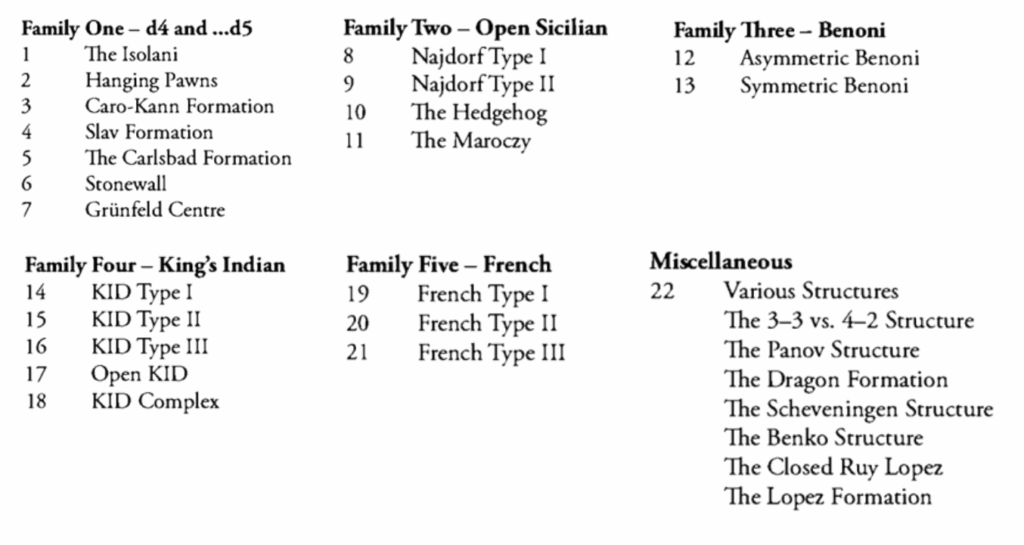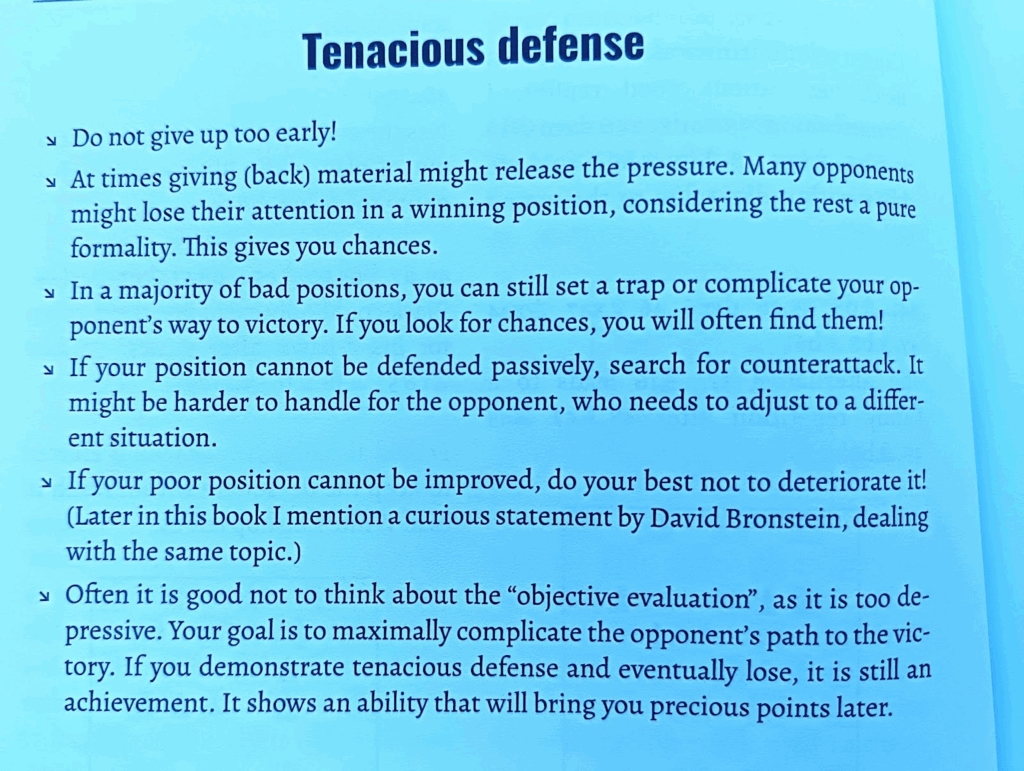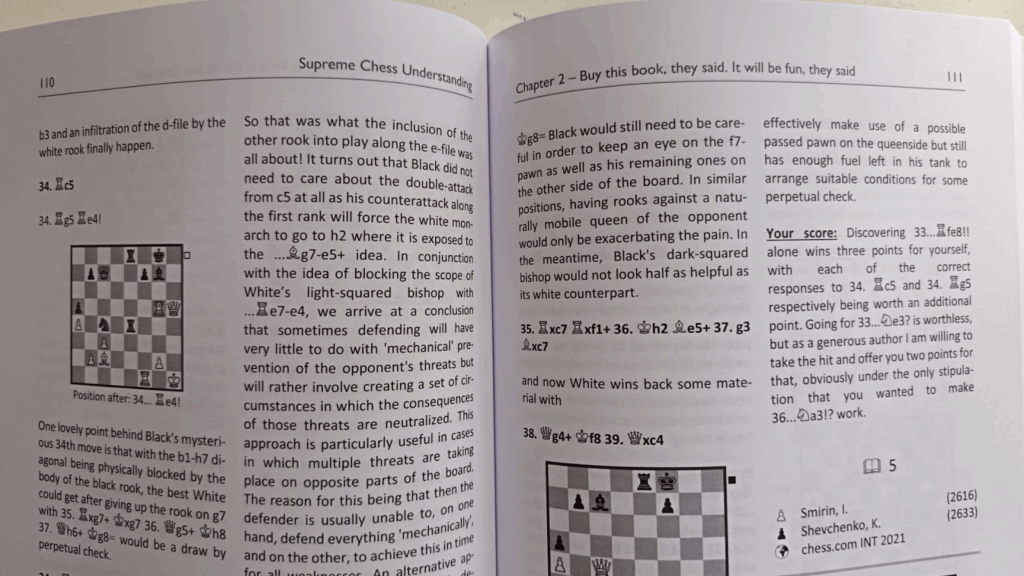Introduction
I’ve heard it many times and have even listed My System as one of my favorite chess books when I was just starting out. I have only read 10 books up to that point, but still. This list is the opposite of that. 8 books almost no one talks about. Chess books that are underrated and yet so incredibly useful every ambitious player should read them. I have tried to include books on the opening, middlegame, and the endgame, as well as books of varying difficulty. They will all be useful for even the strongest masters, though, that is another criteria I’d used. These 8 chess books would benefit anyone’s play, regardless of rating, current skill level, or anything else.
1. Chess Structures: A Grandmaster Guide, Mauricio Flores Rios
Winning or losing most often comes down to understanding what should be done in a position. That always depends on the pawn structure. The pawn structure determines strategy, creates tactical opportunities, and is essential in creating long-term plans. Mauricio Flores Rios has created the ultimate guide to 28 most common pawn structures in chess.

Each pawn structure is explained on a human level with plans for both sides, and plenty of well annotated example games, each with its own lessons neatly listed at the end of the game. This book is rarely mentioned in “top 10” lists by most content creators and coaches, and I can’t understand why. It’s more useful than most of the classic books everyone keeps talking about. Chess Structures alone is enough to be able to navigate almost any type of position on master level.
Read Chess Structures: A Grandmaster Guide
2. Lessons on Uncompromising Play, David Navara
Lessons on Uncompromising Play is a book meant for strong players who are willing to do hard work to progress further. It’s not a book on tactics, strategy, or the endgame, it’s a book on how to play good, uncompromising chess and how to win games. It addresses the key questions of chess: how to win, how to seize the initiative, how to convert when you’re better, how to defend when worse, how to attack, how to handle dynamics, and how to win on demand or in equal positions.

It may be the only book I’ve come across which I suspect may be extremely useful for people above 2500 FIDE. And yet, I was able to understand it perfectly, and had no trouble following Navara’s reasoning.
If you are an advanced player, and you want to go beyond simple concepts when it comes to dynamic play, read Lessons on Uncompromising Play. It’s a remarkably useful and unique book written by a unique guy.
Read Lessons on Uncompromising Play
3. Supreme Chess Understanding, Wojciech Moranda

Supreme Chess Understanding explains the difference between static and dynamic advantages, highlighting the importance of being able to do so while playing, and how knowing where your advantage (or disadvantage) lies enables you to evaluate, plan, and play precisely, according to what the position requires. Moranda goes over each problem in great depth, ensuring proper understanding of all the features of the position one had to appreciate in order to solve it. For everyone who’s already covered the basics of calculation, strategy, and positional play, this book will be a great tool for improving understanding of different types of complex positions.
Read Supreme Chess Understanding
4. Conceptual Rook Endgames Workbook, Jacob Aagaard
Conceptual Rook Endgames Workbook is meant to teach you how to recognize and navigate recurring patterns in themes essential for understanding and playing rook endgames well. It does a very good job of introducing, explaining, and, most importantly, forcing you to become skilled at playing rook endgames. It consists of 208 problems of varying difficulty. The difficulty increases with each chapter.

As Aagaard puts it, “…chapter four is challenging to Grandmasters, and chapter five is simply brutal.” The first three chapters are easier. My completion rate for the 208 problems was 77%, and only 49% for the fifth chapter alone. The Workbook is similar to Aagaard’s other books, and, if you’ve ever read a book from his GM Preparation series, you will see that they are laid out in the exact same way; problems you have to solve followed by clearly written solutions with every relevant variation.
Work your way through the Conceptual Rook Endgames Workbook
5. How to Study Chess on Your Own, Davorin Kuljasevic
How to Study Chess on Your Own is a practical guide on perfecting your chess study. Its purpose is to, as Davorin puts it: “Encourage readers to study with proper structure, and help readers become independent in their study.”

I think the book is intended for adult improvers, although Kuljašević at no point says so himself. Those of us who are struggling, those who have hit a plateau, and those of us who don’t have 10 hours a day they can devote to chess. It has become one of my favorite chess books. The series is intended, as he puts it, for everyone from casual club players to chess professionals. The other three volumes in the series are workbooks, each for a separate level range (1500-1800, 1800-2100, and 2100+).
6. The Art of the Endgame, Jan Timman
The Art of the Endgame is rarely mentioned on best chess books lists, and yet it’s the best collection of endgame studies ever assembled in my opinion. Annotations by Jan Timman are exceptional as well. Solving endgame studies helps your endgame understanding and improves your calculation and visualization, but their main purpose and benefit is broadening your imagination and creativity. Being able to think unorthodoxly, in a creative manner uncommon in real play over the board, helps when dealing with complex positions and helps find resources an untrained eye wouldn’t be able to spot. The Art of the Endgame is considered by many to be the best collection of endgame studies ever written. It will surely enhance your creativity, improve your calculation, and earn you rating points!
7. The Hidden Laws of Chess, Nick Maatman
The Hidden Laws of Chess is a book that teaches how to know what to look at and what to look for in a chess position. It goes way beyond simple concepts, and delves deep into complex problems such as evaluating a space advantage, how to make a difference when positions are symmetrical, how to find value in doubled pawns, and much more. It’s intended for strong players who are trying to make a leap to Master level, despite that, most lower rated players will have no trouble understanding what Maatman explains, which is why I believe this should be a must-read for any ambitious player, regardless of their strength.
Learn The Hidden Laws of Chess
8. Squeezing the Gambits: The Benko, Budapest, Albin and Blumenfeld, Kiril Georgiev
I don’t think I was ever blown away by an opening book before. Georgiev wrote an almost perfect guide on how to deal with four very annoying openings most 1.d4 players dread facing: the Benko, the Budapest, the Albin, and the Blumenfeld. Instead of going over tens of lines that are unlikely to ever happen over the board, giving engine sidelines and weird ideas hard for humans to understand, Georgiev gives applicable strategic tools you can use even if your opponent deviates from book moves.

The way the concepts, ideas, strategy, structures, attacking possibilities and possible sources of counterplay are explained is, as far as I know, unique in the world of boring opening books. Georgiev emphasizes understanding over theory. Lines seldom go more than 15 moves deep, and each move is explained so that a five year-old could understand it easily. I think this is the best book on chess openings ever written.


